Chichen Itza Mayan Pyramids and Temples
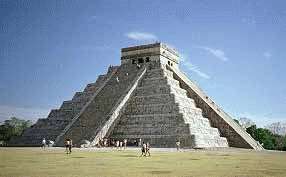
Mayan Pyramid of Kukulkan – The Castle
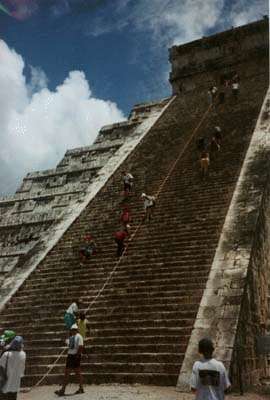
This image of the Mayan Pyramid of Kukulkan at Chichen Itza – Lisa Levy.
Lisa reported that the climb was easy going up – but difficult coming down.
Another friend – Jane Doherty – was guided to take her ancient crystal skull – Maya to the top of the pyramid time during a special solar alignement. the experient made her dizzy and disoriented.
The inside of the pyramid is humid corridors and chambers and also can make one feel ill.
The Temple of the Warriors
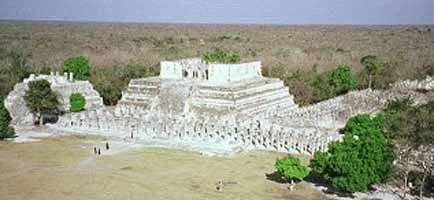
The ‘Temple of the Warriors’ and its adjacent ‘Temple of the Jaguar’ are very impressive ruins of the complex.
A massive temple structure, surrounded by hundreds of columns is carved with reliefs.
My friends – who visit every year feel the energies of the soldiers going by.
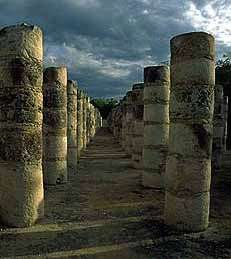
The columns continue on into the jungle, that part of the temple still has not been restored.
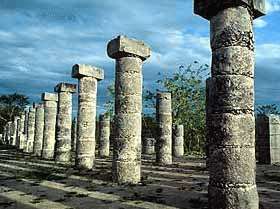
The Observatory – Carocal
![]()
This celestial observatory denotes seasons based on solar alignment at different times of the year.
Lisa said it gave her a weird feeling as if spirits from the past were there.
This area is called the Nunnery which
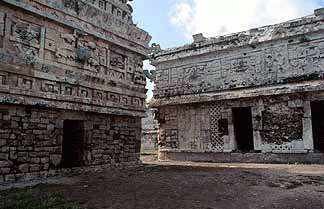
has many ruins that are still intact.
The Mayans were great sportsmen and build huge ballcourts to play their games. The Great Ballcourt of Chich n Itz is 545 feet long and 225 feet wide overall. It has no vault, no discontinuity between the walls and is totally open to the sky. As we approach a silent sentinel stands guard.
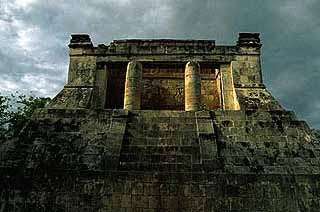
Ball Court Temple
Each end has a raised “temple” area. A whisper from end can be heard clearly at the other end 500 feet away and through the length and breath of the court. The sound waves are unaffected by wind direction or time of day/night. Archaeologists engaged in the reconstruction noted that the sound transmission became stronger and clearer as they proceeded. In 1931 Leopold Stokowski spent 4 days at the site to determine the acoustic principals that could be applied to an open-air concert theater he was designing. Stokowski failed to learn the secret. To this day it has not been explained.
The Cenote are deep water filled sinkholes formed by water percolating through the soft limestone above. Since the porous soil held little water, these underground bodies were extremely important to the city. A visit to one is a spine chilling experience. Entry is through a vertical hole with narrow stair steps carved by the Mayan’s themselves. The air is thick and musty. One misstep on the slimy ledges threatens to send you falling over 20 feet.
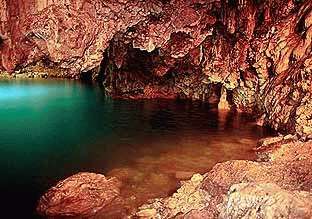
Stalagtites of blood red limestone seem to ooze from the dripping walls. Ahead is a strange green pool of glowing water.
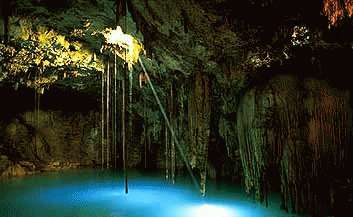
Once a year, in April, the beam of light touches the tip of the stalagmite. There are many instances of ancient peoples building monuments to take advantage of events like these but this is something that is totally natural and unplanned.
– Mysterious Places
An archaeological study of chirped echo from the Mayan pyramid of Kukulkan at Chichen Itza
The massive Kukulcan pyramid called ‘El Castillo’ – the castle – is roughly at the center of the site. Climbing it is quite a challenge and those who make it are rewarded with a spectacular view of the city and surrounding country side. A trip inside the pyramid is quite the opposite. The dark, unbearably humid corridors and chambers are too much for some people.
![]()
Handclaps evoke chirped echoes from the staircases of the Mayan Pyramid of Kukulkan at Chichen Itza. The physics of the chirped echo can be explained quite simply as periodic reflections from stepfaces. But until now, no one has bothered to do so.
What is very interesting is that the chirped echo sounds arguably like the primary call of the Mayan sacred bird, the resplendent Quetzal. This magnificent bird, now near extinction, has for thousands of years represented the ‘spirit of the Maya’. Spirits, in many traditions, speak in echoes. Think of the legend of Echo and Narcissus in the western tradition. Echo, lacking a body, was pure spirit.
A Mayan glyph from the Dresden Codex makes the connection between the pyramid of Kukulkan and the Quetzal bird. This glyph shows Kukulkan, the “sovereign plumed serpent” with a gigantic Quetzal behind him. We argue that the Quetzal bird represents the spirit of the Maya. We also argue that spirits often speak in echoes. It seems most appropriate that the spirit echo of the Mayan Pyramid of Kukulkan would speak in the echo-voice of the Quetzal.”
Even today, the Quetzal plays an important part in modern Mayan culture. (Many modern Maya live in Guatemala, and in the Mexican States of Chiapas and Quintan Roo). Examples: the Quetzal is the unit of currency in Guatemala. The Guatemalan government issues a prestigious award named “The Order of the Quetzal.” The most recent recipient of this award is the great Mayanist, Dr. Linda Schele who passed-on in April, 1998.
Could the Maya have intentionally coded the sound of their sacred bird into the pyramid architecture? I think it is possible. In the millenium since this pyramid was built, though the plaster has eroded from the limestone staircases, the sound is still recognizable.

The Quetzal Bird